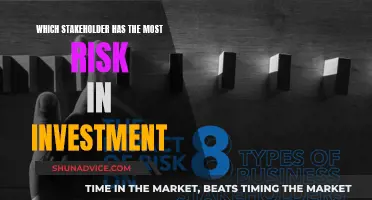
Investing in stocks is a great way to build wealth, and it's possible to start with small amounts of money. One of the easiest ways to invest is by opening an online brokerage account and buying stocks or stock funds. You can also work with a professional financial advisor or robo-advisor, which uses computer algorithms to manage your portfolio at a lower cost than human advisors.
When investing in stocks, it's important to understand the different types of investments available, such as individual stocks, stock funds, mutual funds, bonds, and government bonds. Each investment carries its own level of risk, so it's crucial to consider your financial goals, risk tolerance, and time horizon before deciding where to invest your money.
- High-yield savings accounts: These accounts offer higher interest rates than traditional savings accounts, and your money is easily accessible.
- Money market accounts: MMAs offer FDIC insurance, checking account features, and variable interest rates.
- Certificates of deposit (CDs): CDs are a type of deposit account that allows you to lock in a fixed interest rate for a specified period.
- Government bonds: These are considered safe and low-risk investments, offering reliable income.
- Robo-advisors: Robo-advisors use automated algorithms to manage your portfolio at a lower cost than human advisors.
- Stock funds: Stock funds, such as exchange-traded funds (ETFs) and mutual funds, allow you to invest in a diverse collection of stocks in a single transaction.
| Characteristics | Values |
|---|---|
| Investment options | Stocks, bonds, mutual funds, exchange-traded funds, robo-advisors, brokerage accounts, index funds, high-yield savings accounts, money market accounts, government bonds, treasury bills |
| Investment goals | Short-term, intermediate, long-term |
| Risk tolerance | Low, medium, high |
| Time horizon | Short-term, long-term |
| Investment strategy | Passive, active |

High-yield savings accounts
The Pros
Unlike CDs, which lock in your money for a fixed term, you can withdraw and transfer funds in a high-yield savings account without any penalty. Many accounts also provide optional access to an ATM card. The best high-yield savings accounts come with no monthly fees and low (or no) minimum deposit or balance requirements.
The Cons
Interest rates on high-yield savings accounts are variable and can change at any time. While you can grow your money, it's not the best way to generate long-term wealth for retirement because the yield often doesn't keep up with inflation. Fees and minimum requirements may also apply, and there may be limits on withdrawals. Most high-yield savings accounts are offered by online-only financial institutions, not those with physical locations, which may be a drawback for those who prefer in-person banking.
Investment Management: The Non-Profit Corporate Officer's Role
You may want to see also

Money market accounts
Pros
- Higher interest rates than most bank accounts
- Deposits insured by the FDIC or NCUA
- Check-writing privileges
- May include a debit card
Cons
- May carry higher initial deposit and minimum balance requirements
- Monthly withdrawal limits
- Not suitable for everyday banking due to transaction limits
- Variable interest rates
India's Infrastructure: A Guide to Investing in its Future
You may want to see also

Robo-advisors
How Robo-Advisors Work
Benefits of Robo-Advisors
- Low fees: Robo-advisors typically charge a small fee, usually around 0.25% of your account balance, for their services. This is often much lower than the fees charged by human financial advisors.
- Low minimums: Many robo-advisors have no account minimums or very low minimums, making them accessible to people with smaller amounts to invest.
- Diversification: Robo-advisors build portfolios using a variety of asset classes, including stocks, bonds, and ETFs, providing diversification for investors.
- Convenience: Robo-advisors take care of all the investment decisions for you, so you don't have to spend time researching and managing your portfolio.
- Financial planning tools: Many robo-advisors offer access to financial planning tools and resources to help you make informed decisions about your money.
Choosing a Robo-Advisor
When choosing a robo-advisor, it's important to consider your own financial situation and goals. Here are some factors to keep in mind:
- Fees: Compare the fees charged by different robo-advisors. Look for services with low management fees and no or low account minimums.
- Investment options: Consider the types of investments offered by the robo-advisor. Look for a service that offers a diverse range of asset classes to help balance risk and return.
- Features: Some robo-advisors offer additional features like tax-loss harvesting, automatic portfolio rebalancing, and access to human financial advisors. Choose a service that offers the features you need.
- Performance: While past performance doesn't guarantee future results, it's worth looking at the track record of different robo-advisors to get a sense of their potential returns.
- User experience: Consider the user-friendliness of the robo-advisor's platform. Look for a service with an intuitive interface and helpful customer support.
Overall, robo-advisors can be a great option for people who want a convenient, low-cost way to invest their money. They offer a simple, automated approach to investing that can help you build wealth over time.
E-commerce Investment Strategies for India: A Comprehensive Guide
You may want to see also

Stocks
Choose how you want to invest
You can either opt for a human investment professional, a robo-advisor, or self-manage your investments. A human investment professional is a good option if you want to spend minimal time worrying about investing and have limited knowledge of investing. A robo-advisor is a cheaper alternative that uses an automated program to manage your money. Self-management is a good option if you have the knowledge or time to devote to making investing decisions.
Open an investment account
If you want a professional to manage your money, you can either opt for a human financial advisor or a robo-advisor. A human financial advisor typically charges a per-hour fee or around 1% of your assets annually, with a high investment minimum. Robo-advisors are cheaper and can handle most of your investing needs. If you want to manage your own money, you can open a brokerage account.
Decide what to invest in
If you opt for a robo-advisor or a human advisor, you won't need to decide what to invest in. However, if you are using a brokerage, you will have to select every investment and make trading decisions. You can invest in individual stocks or stock funds. If you are managing your own portfolio, you can also decide to invest actively or passively. Passive investors generally take a long-term perspective, while active investors trade more frequently.
Determine how much you can invest
How much you invest depends on your budget and time frame. While you may invest whatever you are comfortable with, experts recommend that you leave your money invested for at least three years, and ideally five or more. If you can't commit to keeping your money invested for at least three years, consider building an emergency fund first. Most major investment accounts don't have a minimum, so you can get started with a small amount.
Equity Investment Strategies: Where to Invest for Maximum Returns
You may want to see also

Mutual funds
These funds take investors with as little as $500 to start, and many have no minimum. Even with a modest investment, you can own pieces of hundreds of different companies. For example, if you invest $1,000 in a mutual fund with 100 different stocks, it's like buying small slices of all those companies simultaneously.
Some mutual funds are designed to copy popular indexes like the S&P 500—the first mutual funds in the 1970s did exactly this. These are called "passive" funds since the managers are just trying to match a specific index, which takes far less effort than trying to beat the market.
Other mutual funds are actively managed, meaning investment professionals try to beat the market by constantly adjusting their investments. However, these actively managed funds typically charge higher fees, which can eat into your returns over time.
Unlike stocks, which you can buy and sell throughout the day, mutual fund trades only happen once per day after the market closes. The price you pay or receive is based on something called the net asset value—essentially the value of the entire investment pool—which is calculated at the end of each trading day.
If you're looking to start investing in mutual funds, you can do so through a brokerage account. These days, many brokers have $0 account minimums (meaning you can open an account without funding it first), and some even have fractional trading, meaning you can invest low dollar amounts—think $5 or $10—rather than pay for the price of an entire share.
India's Investment Opportunities: Why You Should Invest Now
You may want to see also
Frequently asked questions
There are several options for making small investments, including stocks, bonds, mutual funds, exchange-traded funds (ETFs), high-yield savings accounts, money market accounts, and government bonds. You can also consider using a robo-advisor or a financial advisor to help you manage your investments.
Robo-advisors are a low-cost option for those who want a more automated approach to managing their investments. They use algorithms to build and manage your investment portfolio based on your goals and risk tolerance.
You can start investing with a small amount of money. Many investment options have low or no minimum investment requirements, and some brokers offer fractional share investing, allowing you to buy a portion of a stock or ETF.
Investing in stocks carries risks, as stock prices can fluctuate. If a company performs poorly or goes bankrupt, you may lose some or all of your investment. It's important to do thorough research before investing in individual stocks and consider diversifying your portfolio to manage risk.







